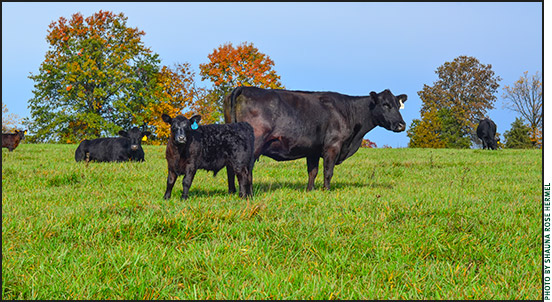
Grazing Season Extension
for the Beef Cow-Calf Producer
Tight forage supplies and lack of available grazing land make the goal of grazing-season extension even more important.
Cost of production for cow-calf producers has risen drastically over the last decade. Because of the widespread drought of 2012 and high cash-crop prices, forage prices remain at record highs and supplies are very tight. Couple that with the fact that available grazing land is also getting harder to find and beef producers can have challenges in keeping their costs of production at profitable levels.
Grain prices remain high and so will the competition for these acres. It’s important that cow-calf producers utilize available land as efficiently as possible to keep feed costs at a reasonable level. Improving grazing management on pastures and utilizing crop residues will be very important for the survival of the cow-calf industry.
Now is a great time to come up with a plan for the 2013 grazing season, because waiting until the grass is ready for turnout makes it extremely challenging for having success at grazing-season extension. Overgrazing in the spring growing season because of a lack of stored or stockpiled forages will also create a disadvantage for the rest of the year and could lead to potential forage shortages for the next winter.
Goals for profitable grazing management should include:
- Meeting the nutritional needs of the livestock from standing forage as many days as possible.
- Harvesting forage with animals as efficiently as possible.
Winter feed cost is the greatest expense of a cow-calf operation. According to data from the North Dakota Farm Business Management Program, total annual cost per cow was $574 in 2011. Of that total cost, 54%, or $309.96, could be attributed to winter feed costs.
Data from North Dakota also indicate that pasture costs are estimated at 85¢ per cow per day, while feeding harvested, stored forages can increase that number to $2.33 per head per day. The stored-forage costs were derived from using $150-per-ton costs on hay and a daily intake of 31 pounds (lb.) of dry matter.
This cost could be much higher if you take into account the cost to purchase hay has since gone over the $150-per-ton price. The Weekly Hay Market Demand and Price Report from the University of Wisconsin has large-round-bale hay prices ranging from $154 to $268 per ton, depending upon quality. Given the difference in the cost of grazing vs. feeding stored forage, it becomes very evident why extending the grazing season is beneficial in keeping production costs as low as possible.
How those grazing acres are managed will also have an effect on the level of cost reduction that is attainable. Utilization rates will vary greatly, depending upon the frequency of the moves; in a continuous paddock situation, the utilization rate would be 30%-40%. Increasing the frequency that the animals are moved will increase the percent utilization.
In a four-year grazing study at the University of Missouri (MU) Forage Systems Research Center, researchers found that moving the fence every three days compared to every two weeks resulted in 40% more grazing days per acre. In other words, if the two-week moves provided 42 grazing days per acre, increasing that to moving every three days would increase the grazing days per acre to 58.
Improving grazing yield will allow producers to better meet forage requirements of the herd during summer slump and into the fall months. The same types of improved efficiency can be found in the grazing of stockpiled forages, crop residues and cover crops. The more frequently cattle are moved to a new paddock, or strip of forage, the higher the utilization rate will be. The level of “management” in the management-intensive grazing (MiG) plan will be the key to higher utilization rates.
Grass from rested pastures or hay fields can be grazed late in the season to improve grazing through summer slump or to extend the grazing season into the fall and winter. Stockpiled forage is typically excellent quality and fits well into MiG, allowing adequate forage plant rest during slow growth times. Saving forage acres for later growth can be difficult, especially if producers usually run out of grazeable acres during late summer or before snow depths inhibit grazing. Producers who typically need to supplement grazing with harvested feeds or who overgraze their late-summer pastures probably need more acres in the grazing system. Producers may also need to re-evaluate the number of animals they are managing and consider de-stocking if necessary. Saving pasture acres is cheaper than feeding harvested, stored feeds.
Crop residues and cover crops also offer an opportunity for grazing-season extension. With the increase in the amount of row crops grown, corn stover and cover-crop grazing are an attractive option for producers wanting to help lower the cost of winter feeding. Grazing cornstalks can create challenges like difficulties associated with providing water and fencing to remote locations; however, grazing stalks and cover crops is incredibly cheap and will significantly decrease cost of production and can be worth the extra effort.
 Editor’s Note: This article was published by Michigan State University Extension. Kable Thurlow is a Michigan State University Extension educator.
Editor’s Note: This article was published by Michigan State University Extension. Kable Thurlow is a Michigan State University Extension educator.





